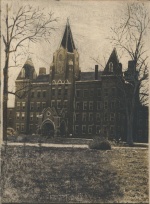Difference between revisions of "Portal:Featured Article Of The Week"
M-Explorer (talk | contribs) |
M-Explorer (talk | contribs) |
||
| Line 1: | Line 1: | ||
{{FAformat | {{FAformat | ||
| − | |Title= | + | |Title= Bolivar State Hospital |
| − | |Image= | + | |Image= Bolivar_State_Hospital_1.jpg |
|Width= 150px | |Width= 150px | ||
| − | |Body= | + | |Body= Western State Mental Hospital, located near Bolivar, was the last state mental hospital to be constructed and habitually the one least funded. In December 1885 the site commissioners chose the farm of Paul T. Jones as the location for the proposed facility. |
| − | The | + | The institution's patient population grew from a few hundred in the 1890s to over 2,000 in the 1960s as patients remained hospitalized for decades. Many were crowded into large dormitories and had little privacy. With a limited number of doctors and attendants and a large patient population, many were simply "warehoused." |
| + | |||
| + | Patients at Western received the treatments available in their period of institutionalization. These treatments ranged from hydrotherapy and insulin shock therapy to lobotomies and electric shock therapy. With the severe staff limitations, however, patients were fortunate to receive ten minutes per week with a psychiatrist. | ||
| + | |||
| + | The system for securing financing for patient care limited the operating budget. In Tennessee, there were three classes of patients: the state-pay patients, the county-pay patients, and the private-pay patients. State agencies agreed to pay for one patient out of a population of one thousand. Once this portion of the payment had been satisfied, the county was responsible for additional costs. The county payments consistently lagged behind, and superintendents had to engage in deficit spending to keep the hospital operating. The two most influential superintendents, Dr. Edwin Cocke and Dr. Edwin Levy, often faced political pressure from state officials, but both managed to make some improvements in the care offered at Western. [[Bolivar State Hospital|Click here for more...]] | ||
}} | }} | ||
Revision as of 04:47, 24 November 2014
Featured Article Of The Week
Bolivar State Hospital
Western State Mental Hospital, located near Bolivar, was the last state mental hospital to be constructed and habitually the one least funded. In December 1885 the site commissioners chose the farm of Paul T. Jones as the location for the proposed facility.
The institution's patient population grew from a few hundred in the 1890s to over 2,000 in the 1960s as patients remained hospitalized for decades. Many were crowded into large dormitories and had little privacy. With a limited number of doctors and attendants and a large patient population, many were simply "warehoused."
Patients at Western received the treatments available in their period of institutionalization. These treatments ranged from hydrotherapy and insulin shock therapy to lobotomies and electric shock therapy. With the severe staff limitations, however, patients were fortunate to receive ten minutes per week with a psychiatrist.
The system for securing financing for patient care limited the operating budget. In Tennessee, there were three classes of patients: the state-pay patients, the county-pay patients, and the private-pay patients. State agencies agreed to pay for one patient out of a population of one thousand. Once this portion of the payment had been satisfied, the county was responsible for additional costs. The county payments consistently lagged behind, and superintendents had to engage in deficit spending to keep the hospital operating. The two most influential superintendents, Dr. Edwin Cocke and Dr. Edwin Levy, often faced political pressure from state officials, but both managed to make some improvements in the care offered at Western. Click here for more...
